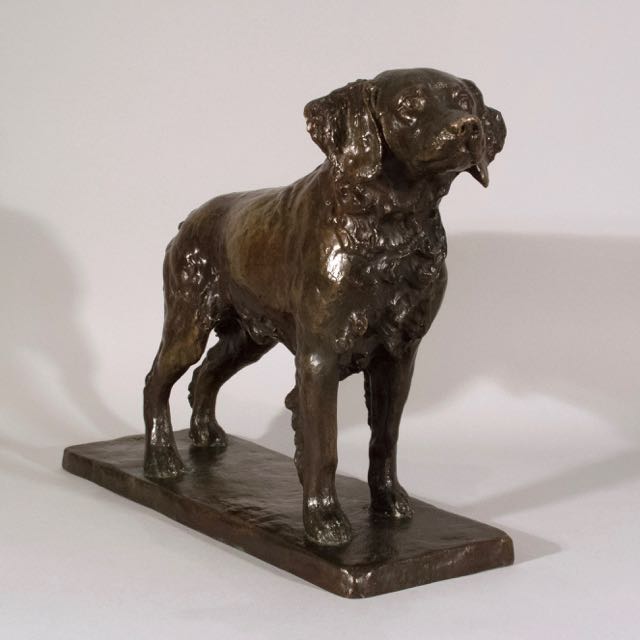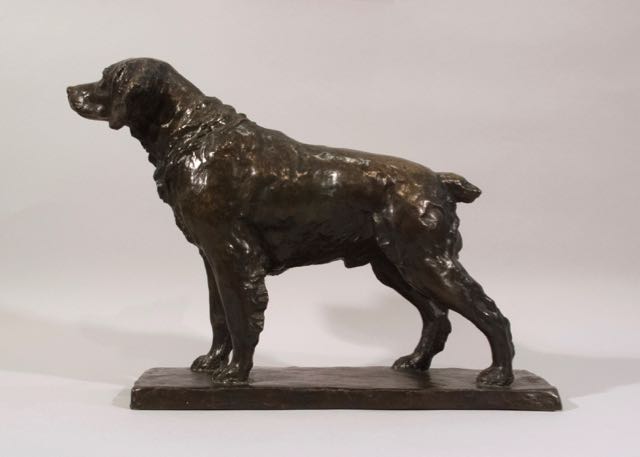❖
SUPPORTING BREED EDUCATION AND RESEARCH
THROUGH PHILANTHROPY
Richard Fath (France 1900-1952) was a French sculptor whose favorite subjects were animals, and particularly dogs. This bronze work of a male Epagneul Breton is widely accepted as one of the most famous artistic interpretations of the Epagneul Breton in existence. This piece, sometimes referenced in the United States as the "Iron Dog Bronze," is uniquely intertwined with the breed's early history in both the United States and France.
The model for this bronze piece was Kaer de Cournoulaille, a dog bred by Emile Bourdon of Callac, Province of Bretane, France, which was imported to the United States in 1936 by Alan Stuyvesant the proprietor of Allamuchy Valley Kennels in Allamuchy, New Jersey. Stuyvesant was perhaps the most enthusiastic early supporter of the Brittany in the United States, and his dog "Kaer," which was trialed in France before being imported, played a large role in gaining early recognition of the breed in the United States as this great dog won several American field trials while competing against pointers and setters. Stuyvesant commissioned Fath to create the bronze sculpture depicting Kaer de Cournoulaille, but several plaster models were developed before the final model was approved by Stuyvesant and several French judges of the Epagneul Breton who were consulted during the course of the project. The judges suggested that the dog be depicted in a pointing position rather than a show/exhibition pose. The end product was represented by all involved to meet a composite of the ideal Epagneul Breton under the existing conformation standard of the breed at the time.
According to information from the French Club de l'Epagneul Breton, the Epagneul Breton Bronze piece was done in a limited edition of ten pieces. Four of the castings are known or believed to reside in the United States. It is assumed that Stuyvesant kept one and that it remains with his family. (Stuyvesant died in an accident on a ship en route to France to visit friends who were involved in the breed.)
Featured Art - May 2016
The Epagneul Breton Foundation, Inc., intends to display artwork in its gallery to inform enthusiasts of the breed about historic and contemporary art and artists. Pieces of art will be featured here periodically and then displayed in its online gallery.
Please contact us to suggest or submit additional items for display.
Epagneul Breton Bronze
Images courtesy of M. William Secord of The William Secord Art Gallery, New York City



Another casting was donated by Stuyvesant as a national trophy for the American Brittany Club. It is held in the Tom Black estate after renowned American trainer Delmar Smith of Big Cabin, Oklahoma permanently "retired" it and donated it as a trophy after his client Tom Black's dog "Towsey" won it three times. A third limited edition casting had been given as a token of appreciation by Stuyvesant to Walter Kleeman, an early pioneer in the American Brittany Club. Following the permanent retirement of the "Towsey" casting, Kleeman's widow donated her late husband's bronze to the American Brittany Club on the condition that it never be retired. To this day, it serves as the national trophy of the American Brittany Club.
A fourth casting of the limited editions was acquired from Fath's son by the William Secord Art Gallery, New York. This particular casting was displayed by the Secord Gallery at a special exhibition of Fath's work in 2003. Secord sold it to a private collector who held it for a number of years, then recently decided to part with it and sold it to a private collector and U.S. Epagneul Breton enthusiast. A fifth limited edition casting is on display at the Museum of the Epagneul Breton in Callac, Province of Bretagne, France. The four remaining pieces are believed to be held in private art collections in France. The owners are unknown to anyone other than perhaps Fath's descendants.
Note: Another famous Fath piece was previously featured by The Epagneul Breton Foundation, a terra cotta head study of an Epagneul Breton. A representation of this piece serves as the foundation's official emblem.